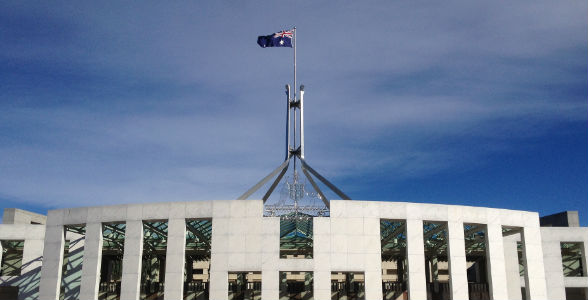Semi-parliamentary government, in Australia and beyond
Australia has developed a unique semi-parliamentary system of government, writes Steffen Ganghof, which assigns different functions to the two equally legitimate but differently constituted houses of parliament. While not an ideal system, it offers an under-appreciated alternative to competing models of presidential and parliamentary democracy.

Parliament House, Canberra. Picture: Ben Terrett, via a (CC BY-NC-ND 2.0) licence
Are the Australian systems of government, at state and federal levels, ‘parliamentary’? Most scholars certainly think so, but there have long been disagreeing voices.
A parliamentary system of government requires that the legislature can dismiss government at any time and even for purely political reasons. The lower houses in Australia certainly possess this power, if only by convention. But, the upper houses do not, even though the Legislative Councils and the Senate are also directly elected and may have an equal or even greater claim to fairly represent the people. Has Australia thus invented a hybrid system, in which one part of the legislature relates to the government as in a parliamentary system, the other as in a presidential system?
My co-authors and I contend that Australia has indeed invented a unique – ‘semi-parliamentary’ – form of government, which should be regarded as a principle alternative to presidentialism.
A core problem of presidential democracy can be witnessed every day in the United States and elsewhere: the lack of any constitutional way to dismiss even an obviously incompetent and immoral president who constantly undermines the norms of liberal democracy. Presidentialism invests massive executive power in a single human being, not a political party. The constitutional separation of powers thus goes along with the lack of an informal, party-based separation of powers.
What is semi-parliamentarism?
In contrast, even if lower house elections in Australia may seem ‘presidentialised’ in their focus on the candidates for the office of the prime minister, the elected prime minister can be sacked and replaced at any time by the majority party. Australian-style separation of powers divides power not between executive and legislature, but between two directly elected parts of the legislature, only one of which fuses its majority with the executive. It is this division of powers that makes Australia (and a few other countries) semi-parliamentary.
This form of government can reconcile any advantages the branch-based separation of powers might have with the majority party’s collective control over the cabinet. It combines formal and informal separation of powers.
One potential advantage of the formal separation of powers is its capacity to balance competing models of democracy. To be sure, we may hope that this is also possible in a pure parliamentary system of government. The hope is that, by designing the electoral system for parliament in a clever way, a party system emerges that adopts some optimal position between the extremes of the pure two-party ‘Westminster’ model and a purely ‘proportional’, multi-party democracy.
Yet our empirical analysis of 29 democratic systems between 1995 and 2015 throws doubt on these hopes. Even if the electoral system succeeds in limiting the number of parties and/or grouping them in two competing pre-electoral alliances, this is always costly in terms of salient democratic values. Moreover, countries that come close to the putative electoral sweet spot, such as Germany or Spain, have recently been unable to prevent the rise of new parties competing along new issue dimensions. This led to great difficulties in forming stable and effective cabinets.
The Australian semi-parliamentary system can balance competing models of democracy by assigning different functions to equally legitimate but differently constituted houses of parliament. A two-party (or two-bloc) lower house serves as a sort of permanent ‘confidence college’ for the cabinet, while the multi-party upper house achieves a fairer representation of groups and interests in the legislative process. Crucially, deliberation and bargaining in this more representative upper house are liberated from the imperative of forming a cabinet and keeping it in office.
All of this is not to say that that Australian bicameralism is optimally designed, or that semi-parliamentary government is necessarily superior to pure parliamentary government. Indeed, if viewed through the analytical lens of ‘semi-parliamentary government’, Australia’s bicameral systems fall short in many ways. Lower houses seem too large and upper houses too small. Moreover, district representation might be better placed in the upper, purely ‘legislative’ house rather than in the confidence college for the prime minister. We could even design semi-parliamentary systems in which voters need only one vote to elect a representative, multi-party parliament as well as a two-party confidence committee embedded within it.
While we certainly don’t expect far-reaching reforms to happen anytime soon in Australia, we believe that semi-parliamentary designs of democracy can be improved and should receive more attention from scholars and reformers all over the world.
This article represents the views of the author and not those of Democratic Audit. It was originally published on Pop Politics Aus and it draws on the journal article: Ganghof, Steffen, Sebastian Eppner, and Alexander Pörschke. 2018. ‘Australian Bicameralism as Semi-Parliamentarism: Patterns of Majority Formation in 29 Democracies.’ Australian Journal of Political Science 53 (2): 211–33.
About the author
 Steffen Ganghof is professor of comparative politics at the University of Potsdam.
Steffen Ganghof is professor of comparative politics at the University of Potsdam.





 Democratic Audit's core funding is provided by the Joseph Rowntree Charitable Trust. Additional funding is provided by the London School of Economics.
Democratic Audit's core funding is provided by the Joseph Rowntree Charitable Trust. Additional funding is provided by the London School of Economics.
Ah the good old “Washminster System” as it’s long been called by us Aussies. The Australian Constitution in many ways is a rewriting of the American Constitution squeezed into a system that can accommodate the Westminster System. The elected Senate has long confused politicians who dream of a pure Westminster system and try to govern as though it was a meaningless copy of the House of Lords, but in the end, the Senate always seems to win.